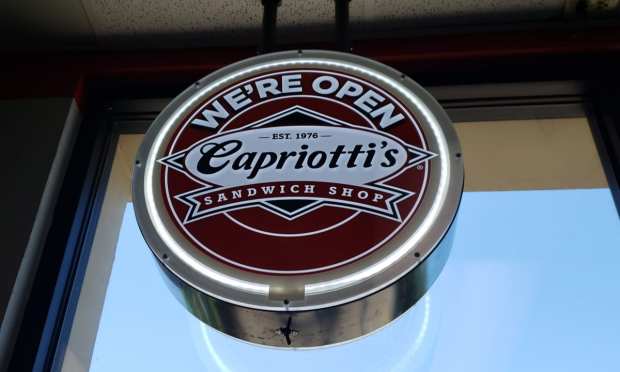Capriotti’s Digital Approach Boosts Fast-Casual ‘Sweet Spot’

After an enormously difficult 13 months, U.S. restaurants are finally starting to come back, as newly vaccinated consumers return for indoor dining, excited to reengage with meaningful culinary experiences after the long stretch away. However, many industry experts believe that takeout and delivery will remain elevated in the “new normal,” and consumers will continue to seek out low-contact options where possible.
Against this backdrop, fast-casual restaurant Capriotti’s Sandwich Shop and its subsidiary Wing Zone are each planning to open 30 new locations across the country in coming months geared toward meeting the rapidly evolving needs of consumers. Emphasizing leading-edge technologies and comprehensive digital ordering options, these restaurants will look to engage consumers across channels.
“People are wanting food delivered … or wanting it wherever they want and whenever they want it — sort of the Amazon-ation of the consumer, and we’ve been investing in Capriotti’s and now Wing Zone for years now, to really make the product easily available,” David Bloom, chief development and operations officer for Capriotti’s and Wing Zone, told PYMNTS in a recent interview. “From a franchisee perspective, being able to have a pretty simple operation of a relatively small real estate footprint, a really attractive return on investment model, and a business that’s in the sweet spot of where the consumer is and where they seem to be going is really attractive.”
Why Fast-Casual Wins In Digital Spaces
That “Amazon-ation,” Bloom explained, refers to the expectation that businesses will meet the need for convenience and for immediacy, offering a degree of flexibility that allows for maximum options on the consumer side. Capriotti’s, he noted, has been offering this to consumers through its partnerships with restaurant aggregators for years.
He said fast-casual is a key part of this “sweet spot” approach to dining. “People still want an upscale experience, they still want a really high-quality product, but they want it delivered, they want it brought to their home, they want it at … more of an affordable price point,” he said.
He added that, given both Capriotti’s and Wing Zone’s decades-long histories and their many locations across the country (or in Wing Zone’s case, around the world), the brands have the advantage in these digital spaces.
“That’s where having brand recognition or name awareness actually pays off the most,” Bloom said. “If you’re online and you’re scrolling through what’s available to have delivered to you, and you’ve never heard of 80 percent of them, you’re a little less likely to take a chance,” he said. “But if it’s a brand name you know, you recognize, and you drive by it, you’ve heard of them, they’ve been around a while — what we refer to as brand equity — that really, really pays off in the digital world and I think that’s going to continue.”
Iterating Rather Than Pivoting
Bloom takes a long view of the restaurant industry, seeing the current trends not as a radical shift from the pre-COVID landscape but as an acceleration of what was already in motion for decades. By his assessment, “Fast casual, for the last 10 or 15 years, has been in that sweet spot, and now it’s just continued.”
The technologies that have been so essential in the last 13 months, he said, “ghost kitchens, off-premises, virtual brands,” and those that are just beginning to become the norm — “everything from robotics, to back-of-the-house automation, to virtual ordering and tableside ordering” — have been part of Capriotti’s strategy long-term strategy.
“We don’t look at these [technologies] as a pivot, which I think a lot of the industry does,” said Bloom. “It’s been more of an iterative process, for us to investigate, test, and then roll out … all the new stuff that’s coming in the industry — it’s already in our roadmap, it’s already in process.”
Winners And Losers
Looking ahead, Bloom believes that the future of fast-casual is “very technology-enabled,” and that “the delta between the winners and the losers is going to be much bigger.” For its part, Capriotti’s has many executives from tech backgrounds, “so technology companies work with us,” he said.
“We do a lot of beta testing for them, because we kind of speak their language,” he said. “I think that’s what tech companies are looking for: people who have a long-term approach, and can really collaborate with them to figure it out, because it never works the first time.”
By Bloom’s assessment, the groups and management teams that are quick to adopt technologies with this kind of long-term view, rather than a quarter-to-quarter view, will be the best positioned to succeed in the years to come, as so many key technologies emerge to optimize every stage of restaurant operations. Restaurants “that have that luxury — whether the capital, the infrastructure or just the alignment amongst their shareholders or stakeholders” will have the edge, he said.
For Capriotti’s part, Capriotti’s Sandwich Shop is planning to reach more than 500 locations by 2025, while Wing Zone is looking to operate 200 profitable restaurants by then, a growth plan enabled by this savvy approach to technology.
“I would just say it’s probably the most interesting and exciting time our industry has seen in a very long time,” Bloom said, “while at the same time it’s going to be the most disruptive time that the industry has seen for a long time. Any time that happens there’s a tremendous amount of opportunity for those with the resources … to take advantage of it. And then for others, their head’s going to spin. For somebody like me who’s been in the business a long time, it’s almost like the golden age of restaurants. It’s never been like this before. So, it’s really fun.”
